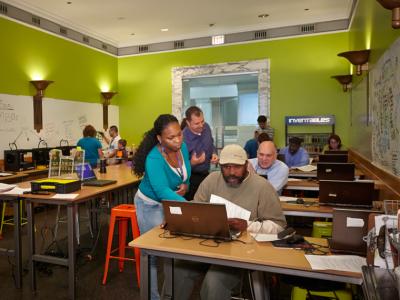PPO intern Janelle Jones recently visited Chicago Public Library's Maker Lab. The lab, located inside the historic Harold Washington Library Center, opened in 2013 and offers free workshops, open lab hours and drop-in demonstrations utilizing high-tech equipment such as digital design software, 3D printers, laser cutters, milling machines and vinyl cutters. The Maker Lab is a community-operated workspace where people with common interests come together to learn and collaborate.
Image

I sit down to these different objects wrapped neatly inside three plastic bags: photorecessor, microcontroller and Arduino software.
“Perhaps I am just a little bit in over my head,” I think.
The instructor, a young guy with red, streaked hair, stands up and introduces himself.
“Hi everyone, I am Derek and welcome to ‘Lights, Music, and Arduino Electronics.’ Today we are going to make music using light.”
Yep, definitely in over my head.
I mean, why would I sign up for a class like this anyway? I do not have a technical background and I don’t even know what an Arduino is, let alone that it can make music using light. But I stick it out, and I’m glad I do. Derek Song, a musician with a degree in electronic music production and design, is an excellent teacher. And there are photos, detailed instructions, jokes, charts, diagrams, more jokes and patience – lots of patience.
About an hour into the class, I have successfully built my very own Theremin, an electronic musical instrument I can control just by moving my hand. It works like this (non-science-minded people may hop to the next paragraph): When the Arduino board is connected to a buzzer, it omits a buzzing noise (naturally). When I wave my hand over a gadget called a photoresistor, I block light from reaching the device, causing the buzz to change in pitch. By attaching a USB to the Arduino board and computer, I can upload a code to change the pitch’s frequency, changing the sound of the “music” to my liking.
This, of course, is a basic version of a Theremin; professional-grade Theremin musical instruments are actually used for concerts. And the real-world applications of this class extend even farther: Arduino software can be used to program your TV remote or even tweet you when your houseplants are thirsty. Pretty cool, eh?
After class, I sit down with Melissa Wagner, a librarian at Chicago Public Library’s Harold Washington Library Center. We chat about the other types of classes the library’s Maker Lab offers, easing people into the space, the challenges of running the lab, and the future of makerspaces.
Programming Librarian: So Arduino boards and Theremins – what made you guys think of teaching a class like this?
Melissa Wagner: This class came about much like how a lot of our classes at the Maker Lab happen: we have someone with an exquisite skill set, like Derek, who brings us the idea, offers to build the curriculum and teach the class.
PL: Do you always have outside instructors come in to teach?
MW: No, not all the time. These classes happen mostly because the staff from different departments volunteers their time. This is a great thing because it makes the process more collaborative and the classes more interesting.
PL: Are the classes always technology-focused?
MW: No, absolutely not. We are very aware that we have patrons who may be intimidated by technology so we made it a point to define the makerspace more broadly. In some of our classes we do not use a computer or technology at all. For instance, we will bring someone from a local flower shop and do a class on flower arrangement.
PL: Oh, that’s very interesting. Is this the strategy to increase attendance?
MW: Yes and no. The overall strategy is to offer access; however, we do believe if we get them through the door, then maybe the technology won’t be as intimidating. And if it’s no longer intimidating then they might sign up for a different class and discover they actually love it. Actually, some of our instructors started as regulars in our classes, and it developed into a passion for them.
PL: What are your plans to get more people involved in the classes?
MW: We launched mini Maker Labs over the summer at three libraries. We wanted to expose people in different neighborhoods to the Maker Lab – people who hadn’t heard of us or were not able to travel to us. That did draw a handful of people to this location.
PL: Is attendance one of the challenges?
MW: It is. When we first opened, the response was overwhelming. But after a year, we find ourselves constantly brainstorming new ways to keep people engaged. We also have to create new curricula for our regulars.
PL: The class I attended was very engaging because Derek was a really great instructor. How do you keep that quality teaching consistent across the board?
MW: We have been coordinating with the staff development department to ensure that everyone’s teaching ability is on the same level so we can take the classes to new heights.
PL: What other sorts of classes or programs do you see in the future for the Maker Lab?
MW: Certainly more of what we’ve been doing. We hope to offer new classes dealing with e-textiles and circuitry. We have a partnership with Chicago’s City Colleges to provide access for our patrons who want to take the next step, maybe toward turning this interest into a career.
PL: Was this the vison for the Maker Lab from the beginning?
MW: Yes. The library’s goal has always been to offer access to information, and considering the trend of technology, a makerspace was the next response. We didn’t know exactly how it would expand, but if technology is a skill that more and more people need to learn, then why shouldn’t it happen at the library?
